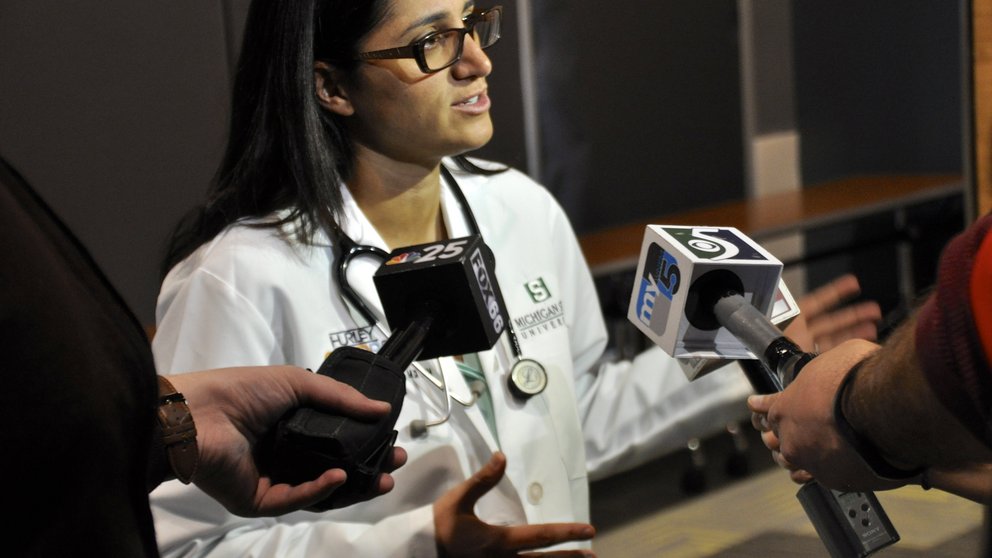
When a health crisis hits a community suddenly and without warning, where is academic medicine? The discovery of toxic levels of lead in Flint, Michigan’s water supply has received global attention. “But the unwritten story is the role of medical education,” explained Mona Hanna-Attisha, MD, MPH, FAAP, assistant professor of pediatrics at Michigan State University (MSU) College of Human Medicine and director of pediatric residency at Hurley Children’s Hospital in Flint.
The world now knows that about 8,000 children under the age of six have been exposed to lead since April 2014 when the source of the city’s water supply was shifted from Lake Huron to the Flint River without adding anticorrosive chemicals. That failure caused pipes to corrode and leach lead into the public water system.
Less well known is the vital role that MSU College of Human Medicine and its partners played in uncovering the problem and in leading efforts to mitigate related health issues. This backstory can serve as an instructive model for other medical schools in preparing for health crises that strike their local communities.
The MSU-Flint bond
Since the automobile industry and related manufacturers left the city over the last three decades, Flint has been struggling. But the city has had a constant friend and resource in its backyard for the last 45 years: MSU College of Human Medicine.
MSU and the affiliated Hurley Medical Center have a solid history of community engagement and public health advocacy for underserved families, including its Leadership in Medicine for the Underserved program for medical students. When the lead crisis erupted, medical students, residents, faculty, and researchers were “strategically placed, already thinking outside the bedside,” said Hanna-Attisha.
High lead levels in the water were first reported by researchers from Virginia Tech University, but Hurley Medical Center researchers quickly set out to measure unknown blood lead levels. Hanna-Attisha and her team documented the dangerously high levels and published a study, “Elevated Blood Lead Levels in Children Associated with the Flint Drinking Water Crisis: A Spatial Analysis of Risk and Public Health Response,” in the American Journal of Public Health in February 2015.
The MSU study showed that the incidence of elevated blood levels increased from 2.4 percent to 4.9 percent after the water source changed to the Flint River; neighborhoods with the highest levels experienced a 6.6 percent increase. Yet no significant change was seen in people living outside Flint.
Long-term effects of lead on young bodies and brains are challenging to predict, but this powerful neurotoxin has long been known to affect development, behavior, intelligence, and speech. The College of Human Medicine rallied to leverage its staff and community partners to address the problem.
“Too often traditional medical education and public health have been in different silos. Doctors have professional credibility, and they should use it to impact the social determinants of health in their communities. We need to educate physicians on the importance of this work.”
Mona Hanna-Attisha, MD, MPH, FAAP
Aron Sousa, MD, interim dean at MSU’s medical school, said that a community participatory infrastructure had been in place before the crisis. In 2012, two years before the water became toxic, the Charles Stewart Mott Foundation awarded the college a $2.8 million planning grant to expand its medical education and public health research in Flint. With this funding, the college formed an advisory committee to work with hospital partners and more than 80 community organizations, government agencies, and the business community to examine social determinants of health in Flint and how to reduce health disparities.
Sousa credits the development and expansion of MSU’s public health program to former dean Marsha Rappley, MD, who is from Flint and a graduate of the college as well. “As dean, Marsha saw that community collaborations across the state would benefit the college and the community, and she has been proven right,” said Sousa. (Rappley, a current member and chair-elect of the AAMC Board of Directors, is now vice president for Virginia Commonwealth University (VCU) Health Sciences and CEO of the VCU Health System).
Early in 2014, several months before high lead levels were discovered, the Mott Foundation granted an additional $9 million to expand the medical school campus in Flint and to recruit six to seven leading public health researchers.
“We wanted community participatory researchers and we could offer named chairs,” said Sousa. “That helped us recruit.”
One of the recruits was Flint native Richard Sadler, PhD, assistant professor of family medicine at MSU and one of the co-authors of the American Journal of Public Health study. Sadler, a health geographer, mapped out areas where children were drinking lead-laced water and geocoded pediatric lead data for 3,000 children under five years of age. His mapping results further proved higher lead levels in the blood of children living in areas where the water had been switched and lower levels in children living outside those areas.
A model public health program
In January 2016, MSU and Hurley Children’s Hospital formed the Pediatric Public Health Initiative (PPHI) with the goal of gathering evidence-based research and to assess, monitor, and intervene in ways that ameliorate the damage to residents who drank the lead-laced water. PPHI, led by Hanna-Attisha, has been bringing together leaders in pediatrics, child development, psychology, epidemiology, nutrition, toxicology, geography, education, and community and workforce development.

Children who have high levels of lead in their blood lead will be monitored. Nutritional and early educational interventions will be provided to those in need. Researchers are continuing to investigate the impact of the water crisis on maternal-fetal outcomes, infertility, newborn heel spots, toxic stress, public trust, and provider knowledge.
“Flint” and “lead” will be linked in the public’s mind for years to come, but the MSU College of Human Medicine and its community partners have a broader long-range focus to serve the community through a variety of programs. Greater Flint has ranked 81st of 82 Michigan counties in unemployment, violent crime, illicit drug use, domestic violence, preterm births, infant mortality, and overall health outcomes. Current MSU programs are addressing mental health issues, drug treatment, maternal-infant support, childcare provider education, and early literacy programs.
In addition, MSU offers a pediatric clinic at the local farmers’ market (and near public transportation) that provides nutrition prescriptions and nutrition education.
What’s the lesson for other medical schools? From Hanna-Attisha’s viewpoint, more institutions need to embrace population health. “Too often traditional medical education and public health have been in different silos. Doctors have professional credibility, and they should use it to impact the social determinants of health in their communities. We need to educate physicians on the importance of this work.”
This article originally appeared in print in the April 2016 issue of the AAMC Reporter.